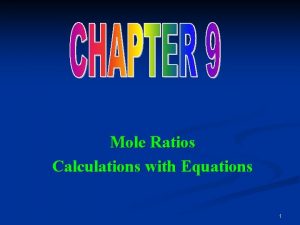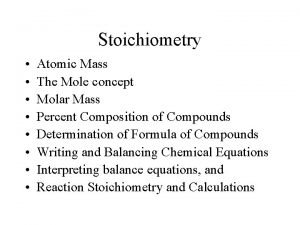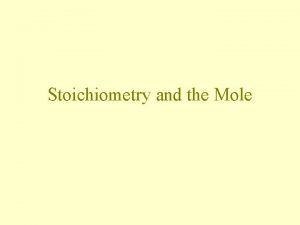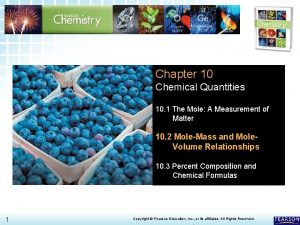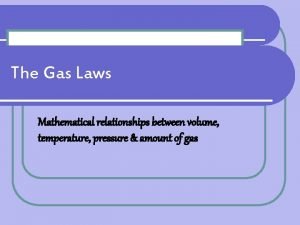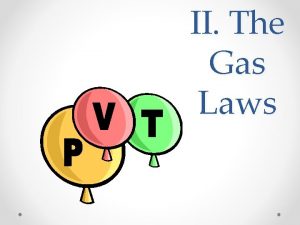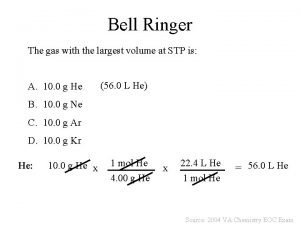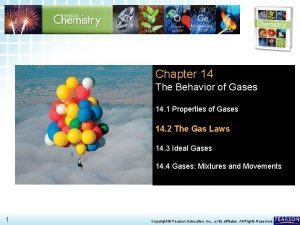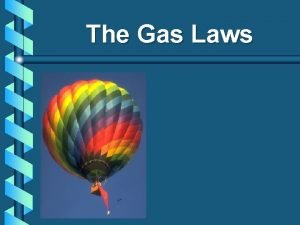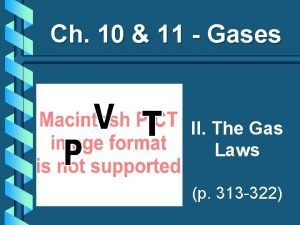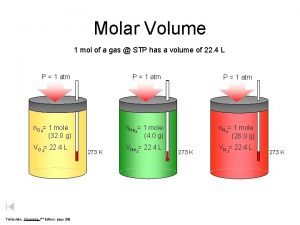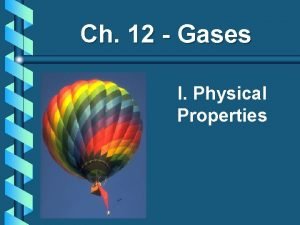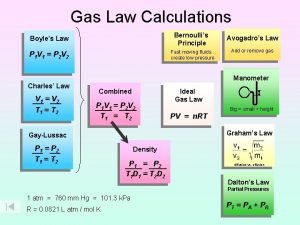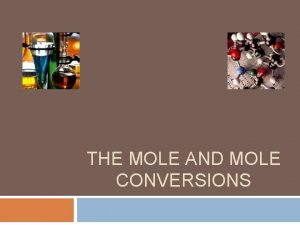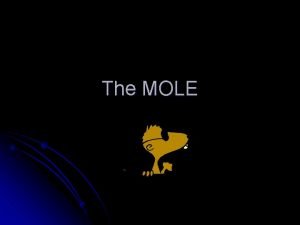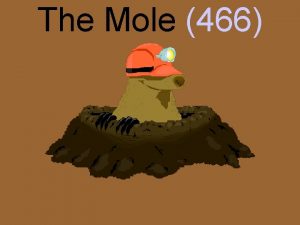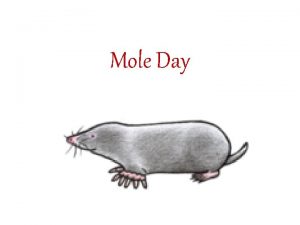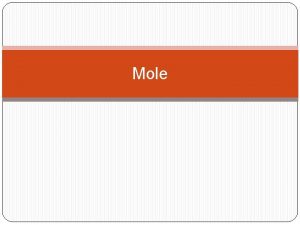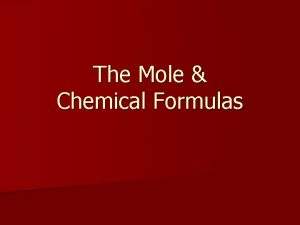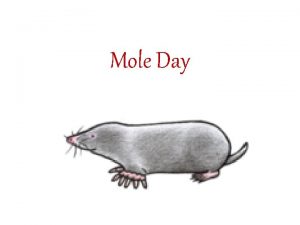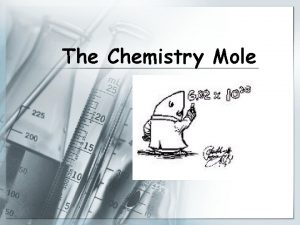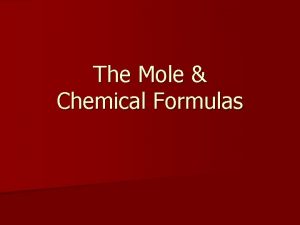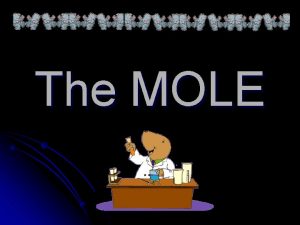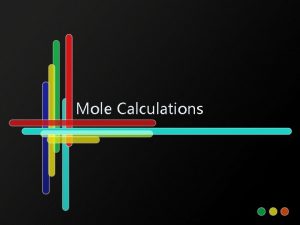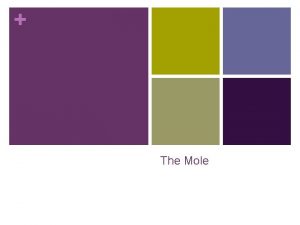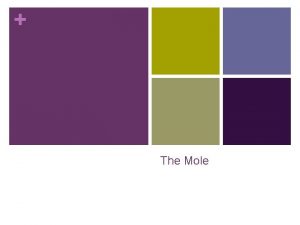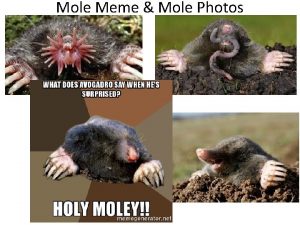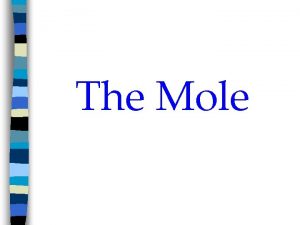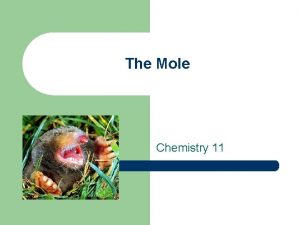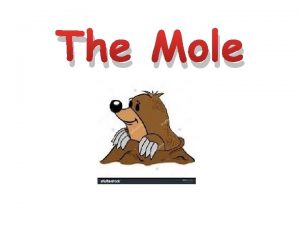The Mole and Energy Mole gas volume and







































- Slides: 39

The Mole and Energy Mole, gas volume and reactions, Chemical energy and Enthalpy,

Index Chemical energy The mole Molar quantities Avogadro’s constant Gas volume Enthalpy changes and specific heat capacity Index for the various types of calculations in higher chemistry

Chemical Energy Thermochemistry is the study of heat energy taken in or given out in chemical reactions. This heat, absorbed or released, can be related to the internal energy of the substances involved. Such internal energy is called ENTHALPY, symbol H. As it is only possible to measure the change in enthalpy, the symbol H, is used. H = H p - Hr Enthalpy (products) – Enthalpy(reactants) Units k. J, kilojoules

The Mole, the amount of a substance. One mole of carbon-12 is the amount of carbon-12 which weighs exactly 12. 000 g. From the relative atomic mass scale we know that Mg weighs x 2 as much as C, 24 amu compared to 12 amu. It follows that 24 g of Mg contains the same number of atoms as 12 g of C. A mole is that amount of substance which contains as many elementary entities as there are carbon atoms in 0. 012 kg of carbon-12. n = mass/GFM mass n x GFM

Molar Quantities You can calculate the number of moles (n) in a substances by: 1. Given the mass, divide the mass by the gram formula mass 2. Given the number of particles, divide the number of particles by Avogadro’s constant. 3. Given the volume and concentration of a solution, multiply the volume by the concentration. 4. Given the volume of a gas, divide the volume by the molar volume.

AVOGADRO’S CONSTANT One mole of any substance contains the gram formula mass (GFM), or molar mass, g mol-1. Avogadro’s hypothesis states that equal volumes of different gases, under STP, contain equal numbers of molecules. Avogadro’s constant, L or NA, is the number of elementary entities (particles) in one mole of any substance Avogadro’s constant = 6. 02 x 1023 formula units Equimolar amounts of substances contain equal numbers of formula units No. Particles n x L

Mole and gas volume The molar volume of a gas is its volume per mole, litre mol-1. It is the same for all gases at the same temperature and pressure. The value, though, is temperature and pressure dependent. The molar volume of all gases is approximately 24 litre mol-1 at 20 o. C and 22. 4 litre mol-1 at 0 o. C. Volume (l) Molar Volume (l) x n

Calculations in Higher Chemistry Main formulae used in calculations Avogadro and the Molar Volume. Calculation from a balanced equation Calculation involving excess Enthalpy of combustion. Enthalpy of neutralisation. Enthalpy of Solution Index

n = number of moles mass n x Gases Units litres (l) No. Particles GFM n Volume (l) x Molar Volume (l) liquids Units mol/l M (Conc. ) n n Volume (l) x M x L

The Mole and Avogadro’s constant How many molecules are in 6 g of water? or 1 Mole of water = 18 g 1 Mole of water = Avogadro’s constant of molecules 18 g 1 g = = Avogadro’s constant of molecules L/18 6 g = (L/18) * 6 1 st work out the number of moles (n) of water Then work out the number of molecules (L) of water using mass n x GFM No. Particles n x L Answer: 2 x 10 23 n = 6/18 = 0. 33 mol No molecules = n x L No molecules = 0. 33 x 6. 02 x 1023 Further calculations

The Mole and Avogadro’s constant is the number of ‘elementary particles’ in one mole of a substance. It has the value of 6. 02 x 1023 mol-1. Worked example 1. Calculate the number of atoms in 4 g of bromine. Step 1: - Identify the elementary particles present Br 2 molecules 1 mole 6. 02 x 1023 Br 2 molecules Step 2: - Change from moles to a mass in grams 160 g 6. 02 x 1023 Br 2 molecules Step 3: - Use proportion. 4 g 4/ 160 x 6. 02 x 1023 Br 2 molecules 0. 505 x 1023 Br 2 molecules Step 4: - Change from number of molecules to number of atoms. 0. 505 x 1023 Br 2 molecules 2 x 0. 505 x 1023 Br atoms 1. 10 x 1023 Br atoms

Calculations for you to try. 1. How many atoms are there in 0. 01 g of carbon? The elementary particles C atoms. 1 mole 6. 02 x 1023 C atoms. 12 g 0. 01 g So 6. 02 x 1023 C atoms. 0. 01/12 x 6. 02 x 1023 C atoms. 5. 02 x 1020 C atoms 2. How many oxygen atoms are there in 2. 2 g of carbon dioxide? The elementary particles So CO 2 molecules. 1 mole 6. 02 x 1023 CO 2 molecules 44 g 2. 2 g 6. 02 x 1023 CO 2 molecules 2. 2/44 x 6. 02 x 1023 C atoms. 3. 01 x 1022 CO 2 molecules The number of oxygen atoms (CO 2) 2 x 3. 01 x 1022 6. 02 x 1022 O atoms

3. Calculate the number of sodium ions in 1. 00 g of sodium carbonate. The elementary particles 1 mole 106 g So 1. 00 g (Na+)2 CO 32 - formula units 6. 02 x 1023 (Na+)2 CO 32 - formula units 1. 00/106 x 6. 02 x 1023 (Na+)2 CO 32 - formula units 5. 68 x 1021 (Na+)2 CO 32 - formula units The number of Na+ ions 2 x 5. 68 x 1021 1. 14 x 1021 Na+ ions

4. A sample of the gas dinitrogen tetroxide, N 2 O 4, contained 2. 408 x 1022 oxygen atoms. What mass of dinitrogen tetroxide was present? The elementary particles 1 mole N 2 O 4 6. 02 x 1023 molecules N 2 O 4 molecules 4 x 6. 02 x 1023 2. 408 x 1024 O atoms So 2. 408 x 1022 O atoms 2. 408 x 1022/ 2. 408 x 1024 mol of N 2 O 4 0. 01 mol So 1 mole of N 2 O 4 92 g 0. 01 mole 0. 92 g End of examples

Molar Volume The molar volume is the volume occupied by one mole of a gas. Worked example 1. In an experiment the density of carbon dioxide was measured and found to be 1. 85 g l-1. Calculate the molar volume of carbon dioxide. So 1 mole, 44 g 1. 85 g occupies 1 litre 1 mole of CO 2 weighs 44 g occupies 44/ 1. 85 x 1 = 23. 78 litres Worked example 2. A gas has a molar volume of 24 litres and a density of 1. 25 g l -1. Calculate the mass of 1 mole of the gas. 1 litre of the gas weighs 1. 25 g So 1 mole, 24 litres weighs 24 x 1. 25 = 30 g

Molar volume What is the mass of steam in 180 cm 3 of the gas, when the molar volume is 24 litres mol-1? 24 litres = one mole of steam, 18 g 1 litre = 18/24 0. 18 litre = (18/24) * 0. 18 Answer: = 0. 135 g Or 1 st work out the using number of moles (n) Then work out the mass using Volume (l) Molar Volume (l) mass n x GFM x n n = 0. 18/24 = 7. 5 x 10 -3 Mass = 7. 5 x 10 -3 x 18

Molar volume Combustion of methane Balanced equation CH 4 (g) + 2 O 2 (g) CO 2 (g) + 2 H 20 (l) Mole relationship 1 mole Gas volume relationship 1 vol 2 mole 2 vol 1 mole 1 vol 2 mole 2 vol What volume of C 02, at STP, is produced if 100 cm 3 of O 2 is used to completely to burn some CH 4 gas? Link 2 vol of O 2 = 1 vol of CH 4. Ans: 50 cm 3

Calculations for you to try. 1. Under certain conditions oxygen has a density of 1. 44 g l -1. Calculate the molar volume of oxygen under these conditions. 1. 44 g occupies 1 litre. 1 mole of O 2 weighs So 1 mole, 32 g occupies 32/ 1. 44 32 g litres = 22. 22 litres 2. A gas has a density of 2. 74 g l-1 and a molar volume of 23. 4 litre mol-1. Calculate the molecular mass of the gas. 1 litre of the gas weighs 2. 74 g So 1 mole, 23. 4 litres weighs 23. 4 x 2. 74 = 64. 1 g End of examples

Calculations from Balanced Equations A balanced equation shows the number of moles of each reactant and product in the reaction. Worked example 1. The equation below shows the reaction between calcium carbonate and hydrochloric acid. Ca. CO 3(s) + 2 HCl(aq) Ca. Cl 2(aq) + CO 2(g) + H 2 O(l) 20 g of calcium carbonate reacts with excess hydrochloric acid. Calculate (a) the mass of calcium chloride formed. (b) the volume of carbon dioxide gas formed. (Take the molar volume to be 23. 0 litre mol -1) Write the balanced equation Show mole ratio Change moles into required units Use proportion Ca. CO 3(s) + 2 HCl(aq) Ca. Cl 2 (aq) + CO 2(g) + H 2 O(l) 1 mol 1 mol 100 g 111 g 23. 0 litres 20 g = 20/ 100 x 111 g 22. 2 g 20/ 100 x 23. 0 litre 4. 6 litres

Calculations for you to try. Excess sodium hydrogen carbonate is added to 200 cm 3 of 0. 5 mol l-1 hydrochloric acid. (Take the molar volume of a gas to be 24 litres per mole) Na. HCO 3 + HCl Na. Cl + CO 2 + H 2 O Calculate the (a) mass of sodium chloride formed. (b) number of moles of water formed. (c) volume of carbon dioxide formed. Na. HCO 3 + The number of moles of HCl used HCl 1 mol 0. 1 mol C x V(l) Na. Cl CO 2 + H 2 O 1 mol 58. 5 g 24 litres 1 mol (0. 1 x 58. 5 g) (0. 1 x 2. 4 l) (0. 1 x 1 mol) = 0. 5 x 0. 2 = 0. 1 mol End of examples + 5. 85 g 2. 4 litres 0. 1 mol

Calculations involving excess As soon as one of the reactant in a chemical reaction is used up the reaction stops. Any other reactant which is left over is said to be ‘in excess’. The reactant which is used up determines the mass of product formed. Worked example. Which reactant is in excess when 10 g of calcium carbonate reacts with 100 cm 3 of 1 mol l-1 hydrochloric acid? Write the balanced equation for the reaction and show mole ratio: Ca. CO 3 + 2 HCl 1 mol mass n gfm Ca. Cl 2 + CO 2 + H 2 O 2 mol Calculate the number of moles of each reactant: Number of moles in 10 g of Ca. CO 3 = Number of moles of HCl = 1 x n C V (l) 100/ 10/100 1000 = 0. 1 From equation 0. 1 mol of Ca. CO 3 needs 0. 2 mol of HCl and as we only have 0. 1 mol of HCl the Ca. CO 3 is in excess.

Excess reactants You can use the relative numbers of moles of substances, as shown in balanced equations, to calculate the amounts of reactants needed or the amounts of products produced. A limiting reactant is the substance that is fully used up and thereby limits the possible extent of the reaction. Other reactants are said to be in excess. Which gas is in excess, and by what volume, if 35 cm 3 of methane is reacted with 72 cm 3 of oxygen? CH 4 (g) + 2 O 2 (g) CO 2 (g) + 2 H 20 (l) 1 mol + 2 mol Link 1 vol to 2 vol, so 35 cm 3 of CH 4 would mean 70 cm 3 of O 2 needed. Ans: O 2 by 2 cm 3

Calculations for you to try. 1. What mass of calcium oxide is formed when 0. 4 g of calcium reacts with 0. 05 mole of oxygen? 2 Ca + O 2 2 Ca. O 2 mol 1 mol Number of moles of Ca in 0. 4 g = 0. 4/ 40 = 0. 01 From equation 2 mol of Ca reacts with 1 mol of O 2. So 0. 01 mol of Ca reacts with 0. 005 mol of O 2. As we have 0. 05 mol of O 2 it is in excess. All 0. 01 mol of Ca is used up From equation 0. 01 mol of Ca will produce 2 x 0. 01 mol of Ca. O 1 mol Ca. O = 56 g 0. 01 mol Ca. O = 0. 56 g

2. What mass of hydrogen is formed when 3. 27 g of zinc is reacted with 25 cm 3 of 2 mol l-1 hydrochloric acid? Zn 1 mol + 2 HCl Zn. Cl 2 + H 2 2 mol 1 mol Number of moles of Zn in 3. 27 g = Number of moles of HCl = 2 x 25/ 3. 27/ 1000 65. 4 = 0. 05 From equation 1 mol of Zn reacts with 2 mol of HCl. So 0. 05 mol of Zn reacts with 0. 1 mol of HCl. As we have only 0. 05 mol of HCl it is the zinc that is in excess. All 0. 05 mol of HCl is used up From equation 0. 05 mol of HCl will produce 0. 5 x 0. 05 mol H 2 0. 025 mol of H 2 weighs 0. 025 x 2 = 0. 05 g End of examples

Enthalpy Changes A. Enthalpy of neutralisation, H neut is the enthalpy change per mole of water formed when an acid is neutralised by an alkali. H neut = -57 k. J mol -1 H+(aq) + OH-(aq) H 20(l) Calculations B. Enthalpy of solution, H soln is the enthalpy change when one mole of substance dissolves completely in water. Calculations C. Enthalpy of combustion, H c is the enthalpy change when one mole of substance burns completely in oxygen, all reactants and products being in their standard states at 25 o. C and 1 atmosphere. Specific heat capacity Calculations

Enthalpy of combustion The enthalpy of combustion of a substance is the amount of energy given out when one mole of a substance burns in excess oxygen. Worked example 1. 0. 19 g of methanol, CH 3 OH, is burned and the heat energy given out increased the temperature of 100 g of water from 22 o. C to 32 o. C. Calculate the enthalpy of combustion of methanol. Use H = -cm T ( c is specific heat capacity of water, 4. 18 k. J kg-1 o. C-1) m is mass of water in kg, 0. 1 kg T is change in temperature in o. C, 10 o. C) H = -4. 18 x 0. 1 x 10 H = - 4. 18 k. J Use proportion to calculate the amount of heat given out when 1 mole, 32 g, of methanol burns. 0. 19 g So 32 g -4. 18 k. J 32/ 0. 19 x – 4. 18 = -704 k. J Enthalpy of combustion of methanol is – 704 k. J mol-1.

Worked example 2. 0. 22 g of propane was used to heat 200 cm 3 of water at 20 o. C. Use the enthalpy of combustion of propane in the data book to calculate the final temperature of the water. From the data booklet burning 1 mole, 44 g, of propane H = -2220 k. J By proportion burning 0. 22 g of propane H = 0. 22/ 44 x – 2220 = - 11. 1 k. J Rearrange H = -c x m x T to give T = H -cm -11. 1 -4. 18 x 0. 2 = 13. 3 o. C Final water temperature = 20 + 13. 3 = 33. 3 o. C

Calculations for you to try. 1. 0. 25 g of ethanol, C 2 H 5 OH, was burned and the heat given out raised the temperature of 500 cm 3 of water from 20. 1 o. C to 23. 4 o. C. Use H = -cm T H = -4. 18 x 0. 5 x 3. 3 = - 6. 897 k. J Use proportion to calculate the enthalpy change when 1 mole, 46 g, of ethanol burns. 0. 25 g So 46 g 46/ 0. 25 -6. 897 k. J x -6. 897 = -1269 k. J mol-1. 2. 0. 01 moles of methane was burned and the energy given out raised the temperature of 200 cm 3 of water from 18 o. C to 28. 6 o. C. Calculate the enthalpy of combustion of methane. Use H = -cm T H = -4. 18 x 0. 2 x 10. 6 = - 8. 8616 k. J Use proportion to calculate the enthalpy change when 1 mole of methane burns. 0. 1 mol -34. 768 k. J 1/ So 1 mol = -88. 62 k. J mol-1. 0. 01 x -34. 768

3. 0. 1 g of methanol, CH 3 OH, was burned and the heat given out used to raise the temperature of 100 cm 3 of water at 21 o. C. Use the enthalpy of combustion of methanol in the data booklet to calculate the final temperature of the water. From the data booklet burning 1 mole, 32 g, of methanol H = -727 k. J By proportion burning 0. 1 g of methanol H = 0. 1/ 32 x – 727 = - 2. 27 k. J Rearrange H = -cm T to give H T = -c m T = -2. 27 -4. 18 x 0. 1 = 5. 4 o. C Final water temperature = 21 + 5. 4 = 26. 4 o. C

4. 0. 2 g of methane, CH 4, was burned and the heat given out used to raise the temperature of 250 cm 3 of water Use the enthalpy of combustion of methane in the data booklet to calculate the temperature rise of the water. From the data booklet burning 1 mole, 16 g, of methane H = -891 k. J By proportion burning 0. 2 g of methane. H = 0. 2/ 16 x – 891 = - 11. 14 k. J Rearrange H = -cm T to give T = H -cm -11. 14 -4. 18 x 0. 25 = 10. 66 o. C End of examples

Enthalpy of neutralisation The enthalpy of neutralisation of a substance is the amount of energy given out when one mole of water is formed in a neutralisation reaction. Worked example 1. 100 cm 3 of 1 mol l -1 hydrochloric acid, HCl, was mixed with 100 cm 3 of 1 mol -1 sodium hydroxide, Na. OH, and the temperature rose by 6. 2 o. C. Use H = -cm T = H = -4. 18 x 0. 2 x 6. 2 H = - 5. 18 k. J The equation for the reaction is: HCl + Na. OH Na. Cl + H 2 O Number of moles of acid used = Number of moles of alkali = C x V (in litres) = 1 x 0. 1 = 0. 1 mol So number of moles of water formed = 0. 1 mol Use proportion to find the amount of heat given out when 1 mole of water is formed. 0. 1 mole -5. 18 k. J So 1 mole 1/ 0. 1 x – 5. 18 = -51. 8 k. J mol-1.

Calculations for you to try. 1. 400 cm 3 of 0. 5 mol l-1 hydrochloric acid. HCl, was reacted with 400 cm 3 of 0. 5 mol l -1 potassium hydroxide and the temperature rose by 6. 4 o. C. Calculate the enthalpy of neutralisation. Use H = -cm T H = -4. 18 x 0. 8 x 6. 4 H = - 21. 40 k. J The equation for the reaction is HCl + KOH KCl + H 2 O Number of moles of acid used = Number of moles of alkali = C x V (in litres) = 0. 5 x 0. 4 = 0. 2 mol So number of moles of water formed = 0. 2 Use proportion to find the amount of heat given out when 1 mole of water is formed. So 0. 2 mole -21. 40 k. J 1 mole 1/ 0. 2 x -21. 40 = -107. 0 k. J mol-1.

2. 250 cm 3 of 0. 5 mol l-1 sulphuric acid. H 2 SO 4, was reacted with 500 cm 3 of 0. 5 mol l -1 potassium hydroxide and the temperature rose by 2. 1 o. C. Calculate the enthalpy of neutralisation. Use H = -cm T = H = -4. 18 x 0. 75 x 2. 1 H = - 6. 58 k. J The equation for the reaction is H 2 SO 4 + 2 Na. OH Na 2 SO 4 + 2 H 2 O 1 mole of acid reacts with 2 moles of alkali to form 1 mole of water. Number of moles of acid used = 0. 5 x 0. 25 = 0. 125 Number of moles of alkali used = 0. 5 x 0. 5 = 0. 25 So number of moles of water formed = 0. 25 Use proportion to find the amount of heat given out when 1 mole of water is formed. 0. 125 mole So 1 mole 1/ 0. 25 -6. 58 k. J x -6. 58 = -26. 32 k. J mol-1.

3. 100 cm 3 of 0. 5 mol l-1 Na. OH is neutralised by 100 cm 3 of 0. 5 mol l-1 HCl. Given that the enthalpy of neutralisation is 57. 3 k. J mol -1, calculate the temperature rise. The equation for the reaction is HCl + Na. OH Na. Cl + H 2 O 1 mole of acid reacts with 1 mole of alkali to form 1 mole of water. Number of moles of acid used = 0. 5 x 0. 1 = 0. 05 Number of moles of alkali used = 0. 5 x 0. 1 = 0. 05 So number of moles of water formed = 0. 05 mol Use proportion to find the amount of energy given out when 0. 05 moles of water is formed. 1 mol So 0. 05 mol T = -57. 3 k. J 0. 05/ 1 x -57. 3 H -cm = = -2. 865 k. J -2. 865 -4. 18 x 0. 2 = 3. 4 o. C End of examples

Enthalpy of solution The enthalpy of solution of a substance is the energy change when one mole of a substance dissolves in water. Worked example 1. 5 g of ammonium chloride, NH 4 Cl, is completely dissolved in 100 cm 3 of water. The water temperature falls from 21 o. C to 17. 7 o. C. Use H = -cm T = H = -4. 18 x 0. 1 x -3. 3 H = 1. 38 k. J Use proportion to find the enthalpy change for 1 mole of ammonium chloride, 53. 5 g, dissolving. 5 g So 53. 5 g 1. 38 k. J 53. 5/ 5 x 1. 38 = 14. 77 k. J mol-1.

Calculations for you to try. 1. 8 g of ammonium nitrate, NH 4 NO 3, is dissolved in 200 cm 3 of water. The temperature of the water falls from 20 o. C to 17. 1 o. C. Use H = -cm T = H = -4. 18 x 0. 2 x -2. 9= H = +2. 42 k. J Use proportion to find the enthalpy change for 1 mole, 80 g, of ammonium nitrate dissolving. 8 g So 2. 42 k. J 80 g 80/ 8 x 2. 42 = 24. 2 k. J mol-1. When 0. 1 mol of a compound dissolves in 100 cm 3 of water the temperature of the water rises from 19 o. C to 22. 4 o. C. Calculate the enthalpy of solution of the compound. Use H = -cm T = H = -4. 18 x 0. 1 x 3. 4 H = -1. 42 k. J Use proportion to find the enthalpy change for 1 mole of the compound. 0. 1 mol - 1. 42 k. J So 1 mol 1/ 0. 1 x -1. 42 = -14. 2 k. J mol-1.

3. The enthalpy of solution of potassium chloride, KCl, is + 16. 75 k. J mol -1. What will be the temperature change when 14. 9 g of potassium chloride is dissolved in 150 cm 3 of water? Use proportion to find the enthalpy change for 14. 9 g of potassium chloride dissolving. 74. 5 g (1 mol) So 14. 9 g 16. 75 k. J 14. 9/ 74. 5 x 16. 75 = Rearranging H = -cm T H Gives T = 3. 35 -4. 18 x 0. 15 End of examples -cm = -5. 34 o. C 3. 35 k. J

Enthalpy Changes A. Combustion of methane CH 4 H (g) CH 4 (g) + 2 O 2 (g) CO 2 (g) + 2 H 2 0 (l) + 2 O 2 H negative, exothermic reaction CO 2 k. J (l) (g) + 2 H 20 reactants products B. Cracking of ethane C 2 H 4 H C 2 H 6 (g) = C 2 H 4 (g) + H 2(g) k. J reactants products H positive, endothermic reaction

Specific heat capacity Calculating the enthalpy change during a chemical reaction in water. H=-cxmx T c m T =specific heat capacity =mass in Kg =temperature change The mass of water can be calculated by using the fact that 1 ml = 1 g. The value for c is usually taken as 4. 18 k. J kg Index – 1 o. C-1
 Mole-mass-volume relationships
Mole-mass-volume relationships Stoichiometry mole-mole problems
Stoichiometry mole-mole problems Mole mole factor
Mole mole factor Stoichiometry worksheet #2 (mole-mass mass-mole problems)
Stoichiometry worksheet #2 (mole-mass mass-mole problems) Phosphorus + oxygen
Phosphorus + oxygen Stoichiometry mole-mole
Stoichiometry mole-mole G/mol to mol
G/mol to mol Concentration mole volume
Concentration mole volume Energy energy transfer and general energy analysis
Energy energy transfer and general energy analysis Energy energy transfer and general energy analysis
Energy energy transfer and general energy analysis Mole by volume
Mole by volume Mole volume relationship
Mole volume relationship Differences between ideal gas and real gas
Differences between ideal gas and real gas Difference between ideal gas and real gas
Difference between ideal gas and real gas Standard temperature and pressure
Standard temperature and pressure Ideal gas vs perfect gas
Ideal gas vs perfect gas Imaginary gas
Imaginary gas Ideal gas vs perfect gas
Ideal gas vs perfect gas Bhopal gas tragedy causes
Bhopal gas tragedy causes Gas leaked in bhopal gas tragedy
Gas leaked in bhopal gas tragedy Gas reale e gas ideale
Gas reale e gas ideale Flue gas desulfurisation gas filter
Flue gas desulfurisation gas filter Poisonous gas leaked in bhopal gas tragedy
Poisonous gas leaked in bhopal gas tragedy Kinetika kimia
Kinetika kimia Gas exchange key events in gas exchange
Gas exchange key events in gas exchange Diketahui 9,2 gram gas no2
Diketahui 9,2 gram gas no2 Sample problem for boyle's law
Sample problem for boyle's law The gas with the largest volume at stp is -
The gas with the largest volume at stp is - A sample of neon gas occupies a volume of 677 ml at 134 kpa
A sample of neon gas occupies a volume of 677 ml at 134 kpa Are gasses highly compressible
Are gasses highly compressible Pv = k
Pv = k A gas occupies 473 cm3
A gas occupies 473 cm3 Stp temperature
Stp temperature A gas occupies 473 cm3 at 36°c. find its volume at 94°c
A gas occupies 473 cm3 at 36°c. find its volume at 94°c Apa arti homogen
Apa arti homogen Volume solid liquid gas
Volume solid liquid gas Find the volume of a balloon of gas at 842 mmhg
Find the volume of a balloon of gas at 842 mmhg Ideal gas constant in kpa
Ideal gas constant in kpa Boyle's gas law formula
Boyle's gas law formula Dr chus
Dr chus


